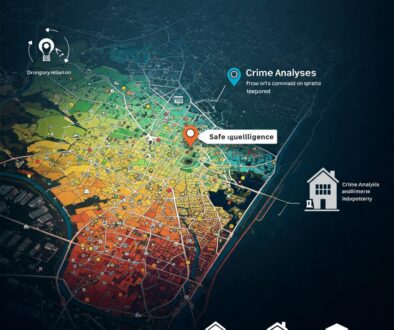School Districts and Property Values: The AI-Mapped Correlation
The connection between school quality and property values has long been recognized in real estate investment. Properties in “good school districts” typically command price premiums and experience stronger appreciation compared to similar properties in areas with lower-rated schools. This relationship is so established that “location near good schools” has become a standard selling point in residential real estate.
However, the traditional understanding of this correlation tends to be simplistic, relying on basic school rankings, test scores, or general reputation. This approach misses the nuanced and evolving nature of how educational factors influence property values in different contexts and for different property types.
In 2025, AI-powered geospatial intelligence platforms like Locas.dev are transforming our understanding of the school district-property value relationship, providing multidimensional analysis that helps investors make more sophisticated decisions about how educational factors will affect their real estate investments.
The Evolution of School District Analysis in Real Estate
Traditional Approach
Conventional assessment of school district impact typically involves:
- Checking standard school ratings from public sources
- Reviewing basic test scores as quality indicators
- Comparing district reputation in the general market
- Observing price differentials across district boundaries
- Noting the presence of “desirable” schools in marketing materials
This approach has significant limitations:
- Oversimplified metrics that miss educational quality nuances
- One-size-fits-all assumptions about buyer preferences
- Limited understanding of different family segments
- Minimal forward projection of changing school quality
- Inadequate differentiation between property types
“The traditional approach essentially treats ‘good schools’ as a binary factor,” explains education economist Dr. Jennifer Wu. “In reality, the relationship between educational quality and property values involves dozens of variables that affect different properties and buyers in remarkably different ways.”
How AI Transforms School District Analysis
Modern geospatial intelligence platforms transform education-related property analysis through:
1. Multi-Dimensional School Quality Assessment
Traditional Approach: Simple reliance on published ratings or test scores as one-dimensional quality measures, missing the complexity of educational excellence.
AI-Enhanced Approach: Sophisticated educational quality intelligence includes:
- Comprehensive performance metrics analysis beyond test scores
- Curriculum strength assessment for different educational priorities
- Teacher quality and retention patterns
- School culture and student support evaluation
- Special program availability and quality assessment
Real-World Impact: “We were comparing two neighborhoods with similarly rated schools by conventional metrics,” notes Michael Chen of Horizon Investments. “The AI analysis revealed that while test scores were comparable, one district had exceptionally strong arts and enrichment programs with high teacher retention, creating stronger parent satisfaction and consistent waiting lists. Properties in this district commanded a 12% premium despite similar headline ratings—a value driver completely missed by traditional analysis.”
2. Demographic-Educational Alignment Analysis
Traditional Approach: General assumption that better-rated schools always increase value, without considering how specific educational characteristics align with different demographic segments.
AI-Enhanced Approach: Detailed alignment intelligence includes:
- Family type matching with educational priorities
- Demographic trend correlation with school characteristics
- Generational preference analysis for educational factors
- International buyer educational priority assessment
- Lifestyle segment educational alignment evaluation
Real-World Impact: A residential developer used demographic-educational alignment analysis to optimize their product mix in a new community. While the area’s schools had moderate overall ratings, AI analysis identified exceptional STEM programs particularly valued by the growing technology-sector families moving to the region. By highlighting these specific educational advantages in their marketing and designing homes that appealed to this demographic, they achieved 23% faster absorption and 9% higher prices than comparable developments using generic “good schools” positioning.
3. Property Type Sensitivity Modeling
Traditional Approach: Simple assumption that school quality affects all residential properties equally, with limited differentiation by property type or buyer profile.
AI-Enhanced Approach: Sophisticated sensitivity intelligence includes:
- Property type-specific school impact quantification
- Unit mix optimization based on educational factors
- Bedroom count sensitivity variation to school quality
- Price point differential analysis across educational quality
- Rental vs. ownership response variation to school factors
Real-World Impact: “The AI analysis revealed that in our target market, three-bedroom townhomes showed 31% higher price sensitivity to school quality than one or two-bedroom units in the same neighborhoods,” explains Sarah Johnson of Meridian Development. “This intelligence led us to concentrate our three-bedroom inventory in the strongest school zones while placing smaller units in areas where other amenities drove value. This strategic allocation maximized overall returns across our portfolio.”
4. Educational Improvement Trajectory Prediction
Traditional Approach: Static assessment of current school ratings without consideration of how educational quality might evolve over time.
AI-Enhanced Approach: Forward-looking educational intelligence includes:
- School performance trend analysis identifying improvement patterns
- Administrative and leadership change impact assessment
- Funding and resource trajectory evaluation
- Demographic shift impact on school performance
- Educational policy reform effect prediction
Real-World Impact: An investor used educational trajectory analysis to identify a neighborhood where school performance was historically average but showed strong positive indicators including recent leadership changes, increasing parental involvement, and improved funding allocations. By investing before these improvements translated to higher ratings, they acquired properties at standard market values that appreciated 28% over three years as school performance improved and reputation followed—significantly outperforming the broader market.
5. School Boundary Evolution Assessment
Traditional Approach: Assumption that current school assignment boundaries will remain fixed, without considering potential redistricting or policy changes.
AI-Enhanced Approach: Comprehensive boundary intelligence includes:
- Redistricting probability assessment based on capacity patterns
- School choice policy evolution prediction
- Assignment methodology change analysis
- Alternative school access probability (charter, magnet, etc.)
- School consolidation risk evaluation
Real-World Impact: “The AI platform identified a significant probability of school boundary adjustments in a rapidly growing suburb,” notes Robert Martinez of Capital Partners. “Population growth and new development were creating capacity pressures that historically led to redistricting in similar districts. This intelligence allowed us to focus on properties in locations that were unlikely to be reassigned based on geographic and demographic factors, avoiding potential value disruption when boundary changes indeed occurred two years later.”
Case Study: The Oakridge Residential Portfolio
When Summit Investments was developing a residential acquisition strategy in a metropolitan area, they employed both traditional educational assessment and AI-powered school district analysis:
Traditional Assessment:
- Properties grouped by school district rating (A, B, C, etc.)
- General price premium noted for higher-rated districts
- Basic test score comparison across different areas
- Standard school quality references in market materials
- Simple boundary map checking for property assignment
AI-Enhanced Intelligence:
- Multidimensional quality assessment revealing hidden strengths in “B-rated” districts
- Demographic analysis showing evolving family profiles with specific educational priorities
- Property type sensitivity model identifying 37% variation in school premium across housing types
- Improvement trajectory prediction spotting three improving school zones before rating changes
- Boundary stability analysis highlighting high-risk and low-risk assignment areas
Based on this comprehensive intelligence, Summit:
- Targeted specific property types in districts with educational characteristics matching demographic trends
- Identified undervalued opportunities in improving school zones before market recognition
- Avoided acquisition in areas with high boundary change probability
- Developed marketing materials highlighting specific educational strengths relevant to target buyers
- Created a phased disposition strategy aligned with projected educational quality recognition
The result was a portfolio that outperformed market benchmarks by 19% over a five-year period by strategically leveraging educational factors beyond simplistic district ratings.
Key Educational Factors Affecting Property Value
Modern geospatial intelligence platforms analyze several critical dimensions to understand educational impact on property values:
1. Academic Quality Dimensions
- Performance metrics beyond standardized tests
- Curriculum strength and specialization
- Teacher quality and stability indicators
- Student-teacher ratio and class size
- Academic resource availability
2. Extracurricular and Support Factors
- Arts and music program quality
- Athletic program strength and facilities
- Special education services and support
- Gifted and advanced learning opportunities
- Before/after school program availability
3. Structural and Administrative Elements
- School facility condition and age
- Administrative leadership quality and stability
- Parent involvement levels and organization
- Safety record and environment
- Technology integration and resources
4. Accessibility and Assignment Factors
- Distance and transportation to schools
- Enrollment policies and flexibility
- School choice availability
- Assignment stability and boundary history
- Alternative school options (private, charter, etc.)
5. Future Trajectory Indicators
- Funding trends and stability
- Demographic evolution affecting student population
- Planned improvements and initiatives
- Policy direction from district leadership
- Community support and engagement patterns
Implementing Educational Intelligence in Your Investment Strategy
To leverage these advanced capabilities in your real estate investment approach:
1. Move Beyond Simple School Ratings
Develop a more sophisticated understanding of educational quality:
- Consider multiple dimensions of school performance
- Evaluate specific programs and strengths beyond test scores
- Assess teacher quality and stability factors
- Analyze school culture and community engagement
- Consider how different educational factors align with target market preferences
2. Match Properties to Educational Profiles
Strategically align your real estate investments with educational factors:
- Target specific property types based on school sensitivity analysis
- Align unit mix with educational priorities in different areas
- Match development timing to school improvement trajectories
- Position marketing around specific educational strengths relevant to target buyers
- Develop amenities that complement educational priorities
3. Identify Value Opportunities in Educational Transitions
Focus on areas experiencing positive educational change:
- Look for early indicators of school improvement before rating changes
- Identify leadership and funding changes that precede performance improvement
- Recognize demographic shifts that may drive educational enhancement
- Monitor policy initiatives that could transform school quality
- Invest before market recognition of educational improvements
4. Mitigate Educational Risk Factors
Protect investments from educational quality challenges:
- Assess boundary stability and redistricting risk
- Evaluate enrollment trend sustainability
- Consider funding stability and resource adequacy
- Monitor leadership continuity and vision
- Analyze demographic shifts that might impact school performance
5. Optimize Educational Value Capture
Maximize the value premium associated with educational quality:
- Highlight specific educational attributes valued by target buyers
- Align renovation and improvement investments with educational strengths
- Time disposition strategies around school quality recognition cycles
- Create value-add opportunities through educational information provision
- Develop community connections that enhance school-neighborhood integration
The Future of Educational Impact Intelligence
As AI and geospatial intelligence continue to evolve, several emerging capabilities promise even more sophisticated educational impact analysis:
Personalized Educational Value Mapping
Future systems will create buyer-specific educational value models, showing how different family profiles value various educational characteristics differently and helping target marketing accordingly.
Dynamic School Quality Prediction
Advanced platforms will continuously monitor early indicators of school quality changes, providing real-time alerts about emerging improvements or challenges before they affect conventional metrics.
Educational Policy Impact Simulation
AI will increasingly model how proposed policy changes might affect school quality and assignment patterns, enabling proactive investment strategies ahead of educational transformations.
Virtual School Tour and Experience Integration
Future platforms will incorporate virtual school experiences and classroom observations, providing more intuitive understanding of qualitative factors beyond metrics and ratings.
Community-School Relationship Optimization
Systems will recommend specific community engagement and school support initiatives that create mutual benefit between real estate developments and educational institutions.
Conclusion: From School Ratings to Educational Intelligence
The relationship between schools and property values extends far beyond simple ratings and district boundaries. The evolution from basic school quality checking to sophisticated AI-powered educational intelligence enables investors to:
- Identify value opportunities missed by simplistic educational assessment
- Match properties and developments to specific educational strengths
- Anticipate educational quality changes before market recognition
- Mitigate risks from boundary and assignment changes
- Optimize marketing and positioning around educational factors
In a market where buyers increasingly consider nuanced educational factors beyond headline ratings, the competitive advantage belongs to investors who can incorporate sophisticated educational intelligence into their real estate strategies.
Ready to transform your understanding of how schools impact property values? Try Locas.dev today and experience the power of AI-driven educational intelligence for your real estate investments.
This article reflects the current state of AI technology in educational impact analysis for real estate. For the latest updates and features, visit Locas.dev.
Keywords: school district property values, real estate school quality, property school correlation, school zone real estate, educational property premium, school district home values, AI educational analysis



